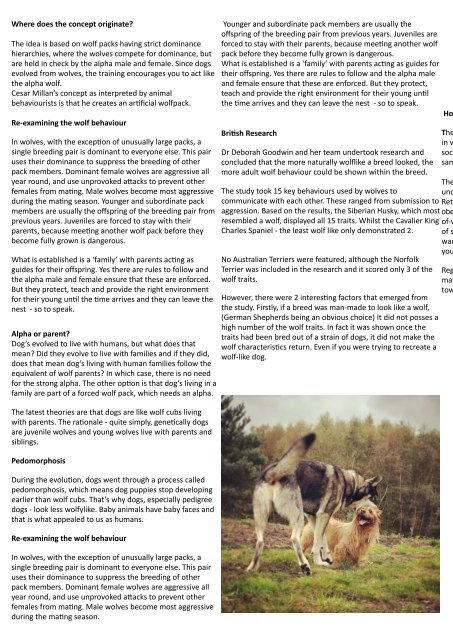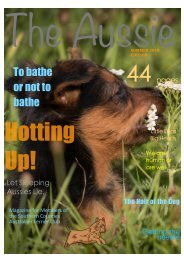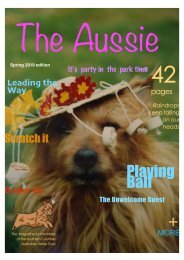The Aussies 2019 - Members version
Magazine for Member of the Southern Counties Australian Terriers
Magazine for Member of the Southern Counties Australian Terriers
You also want an ePaper? Increase the reach of your titles
YUMPU automatically turns print PDFs into web optimized ePapers that Google loves.
Where does the concept originate?<br />
<strong>The</strong> idea is based on wolf packs having strict dominance<br />
hierarchies, where the wolves compete for dominance, but<br />
are held in check by the alpha male and female. Since dogs<br />
evolved from wolves, the training encourages you to act like<br />
the alpha wolf.<br />
Cesar Millan’s concept as interpreted by animal<br />
behaviourists is that he creates an arDficial wolfpack.<br />
Re-examining the wolf behaviour<br />
In wolves, with the excepDon of unusually large packs, a<br />
single breeding pair is dominant to everyone else. This pair<br />
uses their dominance to suppress the breeding of other<br />
pack members. Dominant female wolves are aggressive all<br />
year round, and use unprovoked a2acks to prevent other<br />
females from maDng. Male wolves become most aggressive<br />
during the maDng season. Younger and subordinate pack<br />
members are usually the offspring of the breeding pair from<br />
previous years. Juveniles are forced to stay with their<br />
parents, because meeDng another wolf pack before they<br />
become fully grown is dangerous.<br />
What is established is a ‘family’ with parents acDng as<br />
guides for their offspring. Yes there are rules to follow and<br />
the alpha male and female ensure that these are enforced.<br />
But they protect, teach and provide the right environment<br />
for their young unDl the Dme arrives and they can leave the<br />
nest - so to speak.<br />
Alpha or parent?<br />
Dog’s evolved to live with humans, but what does that<br />
mean? Did they evolve to live with families and if they did,<br />
does that mean dog’s living with human families follow the<br />
equivalent of wolf parents? In which case, there is no need<br />
for the strong alpha. <strong>The</strong> other opDon is that dog’s living in a<br />
family are part of a forced wolf pack, which needs an alpha.<br />
<strong>The</strong> latest theories are that dogs are like wolf cubs living<br />
with parents. <strong>The</strong> raDonale - quite simply, geneDcally dogs<br />
are juvenile wolves and young wolves live with parents and<br />
siblings.<br />
Pedomorphosis<br />
During the evoluDon, dogs went through a process called<br />
pedomorphosis, which means dog puppies stop developing<br />
earlier than wolf cubs. That’s why dogs, especially pedigree<br />
dogs - look less wolfylike. Baby animals have baby faces and<br />
that is what appealed to us as humans.<br />
Re-examining the wolf behaviour<br />
In wolves, with the excepDon of unusually large packs, a<br />
single breeding pair is dominant to everyone else. This pair<br />
uses their dominance to suppress the breeding of other<br />
pack members. Dominant female wolves are aggressive all<br />
year round, and use unprovoked a2acks to prevent other<br />
females from maDng. Male wolves become most aggressive<br />
during the maDng season.<br />
Younger and subordinate pack members are usually the<br />
offspring of the breeding pair from previous years. Juveniles are<br />
forced to stay with their parents, because meeDng another wolf<br />
pack before they become fully grown is dangerous.<br />
What is established is a ‘family’ with parents acDng as guides for<br />
their offspring. Yes there are rules to follow and the alpha male<br />
and female ensure that these are enforced. But they protect,<br />
teach and provide the right environment for their young unDl<br />
the Dme arrives and they can leave the nest - so to speak.<br />
BriBsh Research<br />
Dr Deborah Goodwin and her team undertook research and<br />
concluded that the more naturally wolflike a breed looked, the<br />
more adult wolf behaviour could be shown within the breed.<br />
<strong>The</strong> study took 15 key behaviours used by wolves to<br />
communicate with each other. <strong>The</strong>se ranged from submission to<br />
aggression. Based on the results, the Siberian Husky, which most<br />
resembled a wolf, displayed all 15 traits. Whilst the Cavalier King<br />
Charles Spaniel - the least wolf like only demonstrated 2.<br />
No Australian Terriers were featured, although the Norfolk<br />
Terrier was included in the research and it scored only 3 of the<br />
wolf traits.<br />
However, there were 2 interesDng factors that emerged from<br />
the study. Firstly, if a breed was man-made to look like a wolf,<br />
(German Shepherds being an obvious choice) It did not posses a<br />
high number of the wolf traits. In fact it was shown once the<br />
traits had been bred out of a strain of dogs, it did not make the<br />
wolf characterisDcs return. Even if you were trying to recreate a<br />
wolf-like dog.<br />
Ho<br />
<strong>The</strong><br />
in w<br />
soci<br />
sam<br />
<strong>The</strong><br />
und<br />
Retr<br />
obe<br />
of-w<br />
of s<br />
war<br />
you<br />
Reg<br />
mat<br />
tow









